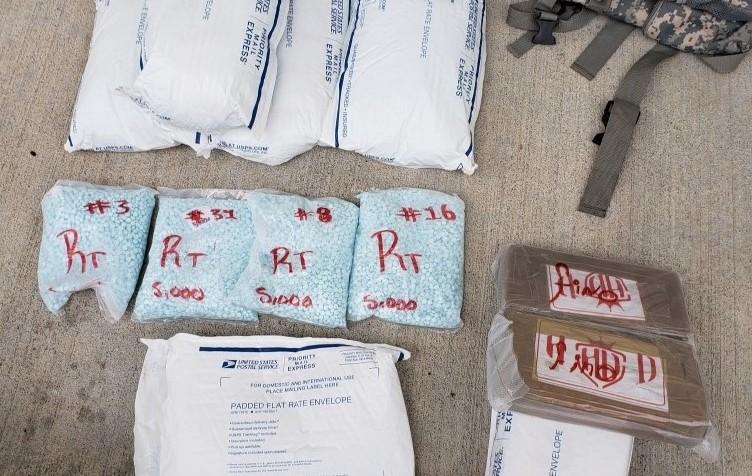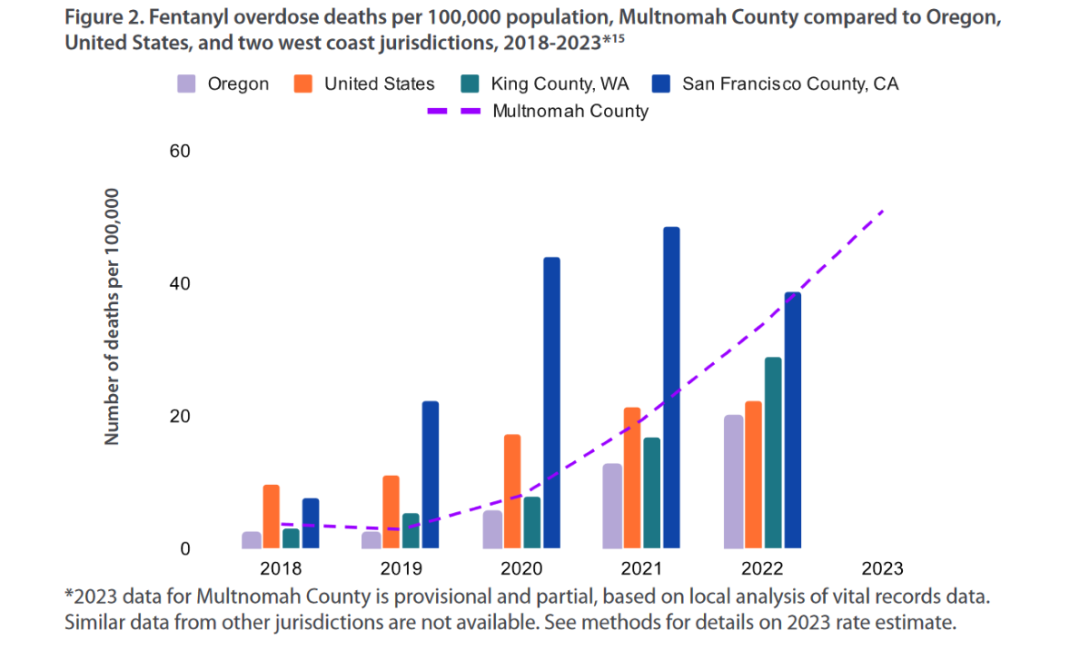
Fentanly caused the death of roughly one person per day in 2023 in Multnomah County, skyrocketing in five years from what had been a few fatal overdoses per month, according to a new report.
Health officials in Oregon’s largest county released the report on Tuesday, barely a week after Gov. Tina Kotek and other officials concluded a 90-day state of emergency intended to address Portland’s downtown fentanyl crisis. The report offers new data on how the proliferation of the powerful synthetic opioid has affected different demographic groups and how Multnomah County compares to other jurisdictions.
Multnomah County Epidemiology Manager Emily Mosites said during a press briefing that the report is different from the county’s online dashboard that provides near real time data on drug overdoses.
“The purpose of this report is a little bit different,” she said. “It tells us who is affected in this crisis.”
The report found that 868 people died of fentanyl overdoses in Multnomah County between 2018 and 2023, at a rate that became alarmingly more frequent.
There were about three deaths on average per month in 2018, according to the report. By 2021 that number jumped to 13. It jumped even higher to 36 in 2023.
“We want to validate the community’s experience. So whereby communities are feeling this, these sorts of data reports validate that experience, and can be used as a call to action to support investments in their communities,"
While Multnomah County isn’t among the counties nationally with the highest fentanyl overdose rates, the report concludes there is cause for alarm. Multnomah County’s fatal overdose rate has surpassed other West Coast cities and is falling primarily on the county’s Black and Native communities.
The report points to a “disproportionate burden… that our communities of color are bearing,” Multnomah County Health Department Director Rachael Banks said during a press conference.
The report suggested that isolation brought on by the COVID-19 pandemic contributed to the rise in overdoses. It states that the increase in deaths and disproportionate impact on some communities “demand collective attention and action across our community and from people in all walks of life: parents, educators, people who are using fentanyl, people in recovery, medical professionals, public health professionals, first responders, and neighbors.”
Demographics
Multnomah County residents aged 34 to 44 have emerged as the age group with the highest risk for fatally overdosing on fentanyl, the report found.
Males in Multnomah County have consistently been at greater risk than females of fatal fentanyl overdoses, a gap Mosites said has widened recently. After adjusting for age, the report put the fentanyl overdose death rate for males in 2022 at about 46 per 100,000 — three times higher than women.
Mosites said that in addition to revealing who is at higher risk of fatal overdosing on the drug, it also shows what demographic groups “might be moving towards increasing inequity and risk.”
“Multnomah County does not have the highest rate in the country. The eastern seaboard really was hit hard with fentanyl earlier on in this crisis, and then fentanyl moved to the West Coast,"
“Although the highest number of fentanyl related deaths in these data was in white residents, the (per capita) rates were highest in the American Indian/Alaskan Native community and in the Black community,” she said. “
Overall, the report found that with 672 deaths, white residents accounted for roughly three-quarters of the county’s fatal fentanyl overdoses between 2018 and 2022.
However, people of American Indian/Alaska Native descent had the highest rate of fentanyl overdose deaths at about 162 per 100,000. Black residents followed at 67 per 100,000 and white residents at 29 per 100,000.
While Hispanic or Latino residents accounted for a smaller share of deaths, the report found their rate of fatal overdoses rose the highest, jumping 225% between 2021 and 2022.
“We want to validate the community’s experience,” Banks said. “So whereby communities are feeling this, these sorts of data reports validate that experience, and can be used as a call to action to support investments in their communities.”
She said the department has programs aimed at preventing youth and others from beginning drug use, as well as reducing the harm of substance use and treatment services.
“Our job is to make those available for anyone who needs them in the county,” she said. “But more specifically, data like this help us to tailor those interventions.”
Banks said Native, Black and Latino communities are working with health workers and treatment providers to raise awareness of fentanyl. Specifically, she said that the county is working with the Future Generations Collaborative, a nonprofit focused on the Native population that is putting on training.
She also said a county program called Racial and Ethnic Approaches to Community Health is working on a communications strategy targeted at the county’s Black and Latino populations. Another county program offers culturally specific services that connect people using drugs to treatment.

Compared to elsewhere
The report found that the rate of fentanyl overdose deaths in Multnomah County has surpassed other West Coast jurisdictions..
In 2018, the overall fentanyl death rate for the U.S. was about 10 per 100,000, while Multnomah County’s rate was less than half at 4 per 100,000.
Multnomah County’s rate was lower than in San Francisco County but slightly higher than in King County, Washington.
By 2022, Multnomah County’s rate caught up with San Francisco and exceeded the rate for King County and the U.S.
The report states that the U.S. fatal fentanyl overdose rate grew to 22 per 100,000. In Multnomah County, the rate grew to 35 per 100,000.
“Multnomah County does not have the highest rate in the country,” Mosites said. “The eastern seaboard really was hit hard with fentanyl earlier on in this crisis, and then fentanyl moved to the West Coast.”
The five counties with the highest rates of fentanyl overdoses in 2022 were all in West Virginia, according to the report.
